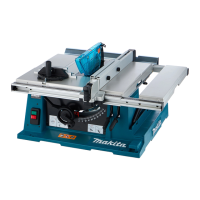19
Miter gauge
Use the miter gauge for the 4 types of cutting shown in the figure.
CAUTION:
• Secure the knob on the miter gauge carefully.
• Avoid creep of workpiece and gauge by firm workholding arrangement,
especially when cutting at an angle.
• NEVER hold or grasp the intended “cut-off” portion of the workpiece.
• Always adjust the distance between the end of the miter gauge and the
saw blade not to exceed 15 mm.
Miter gauge positive stop
Miter gauge is provided with positive stops at 90°, 45°right and left miter
angles for quick setting of miter angles.
To set the miter angle, loosen the knob on the miter gauge.
Raise the small plate on the miter gauge for free setting. Turn the miter gauge
to the desired miter angle. Return the small plate on the miter gauge to the
original position and tighten the knob clockwise securely.
Use of miter gauge
Slide the miter gauge into the thick grooves in the table. Loosen the knob on
the gauge and align to desired angle (0° to 60°). Bring stock flush up against
fence and feed gently forward into the blade.
Auxiliary wood facing (miter gauge)
To prevent a long board from wobbling, fit the miter gauge with an auxiliary
fence board. Fasten with bolts/nuts after drilling holes, but fasteners must not
protrude from the face board.
1. CROSS CUTTING
2. MITERING
3. BEVEL CUTTING
4. COMPOUND MITERING
(ANGLES)
12
34
006166
1. Knob
2. Small plate
3. Screw for positive stop
1
3
2
006225
1. Groove
2. Miter gauge
3. Knob
1
2
3
006167
006168

